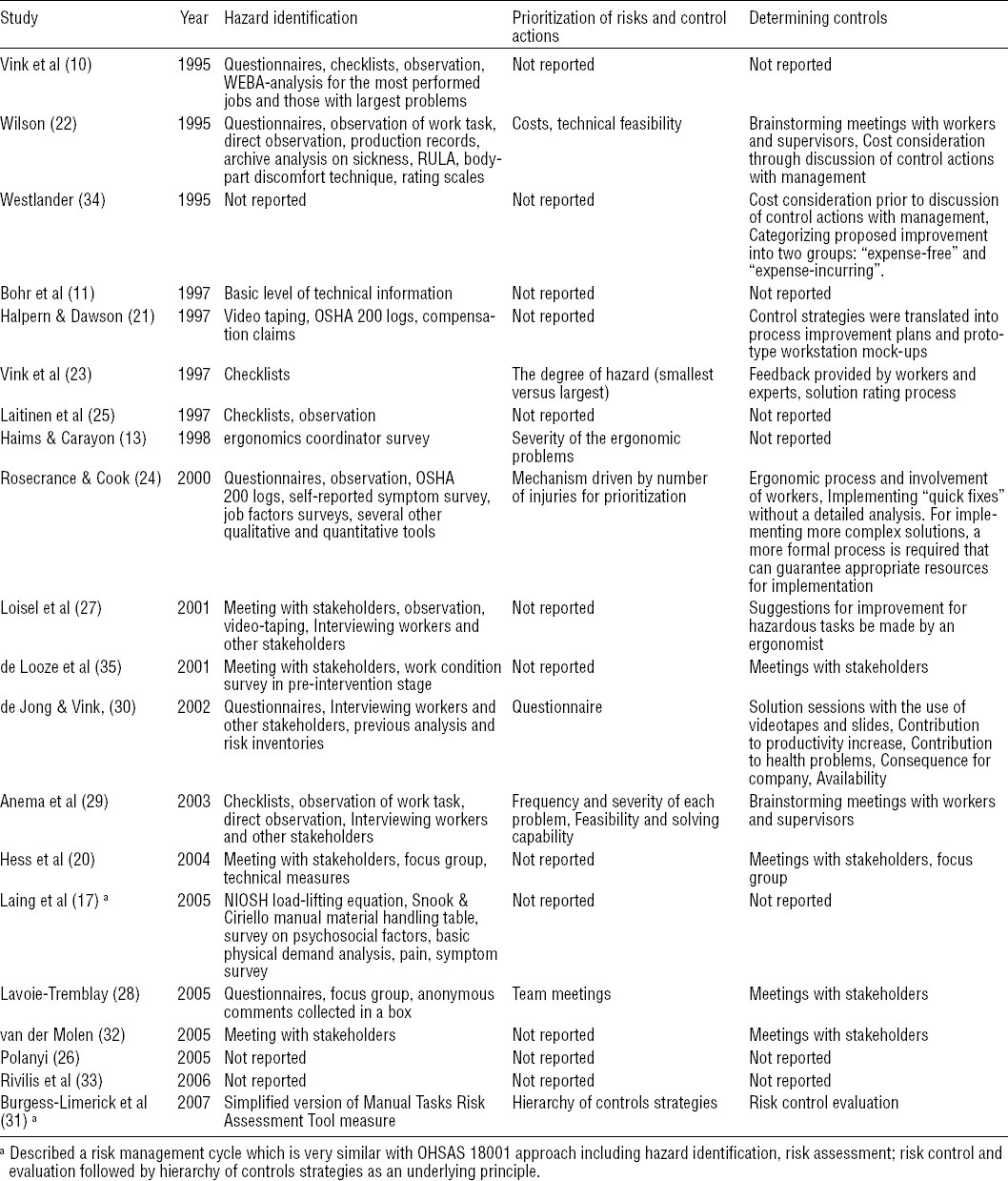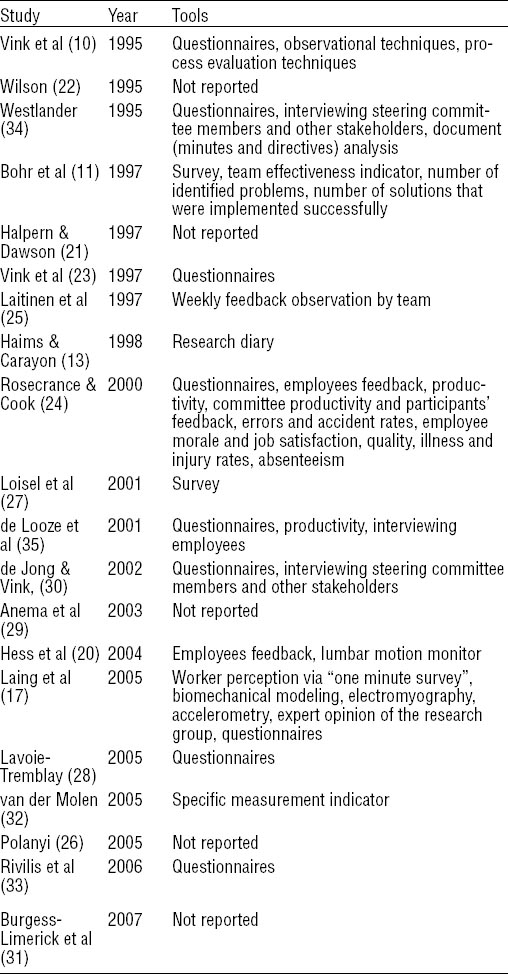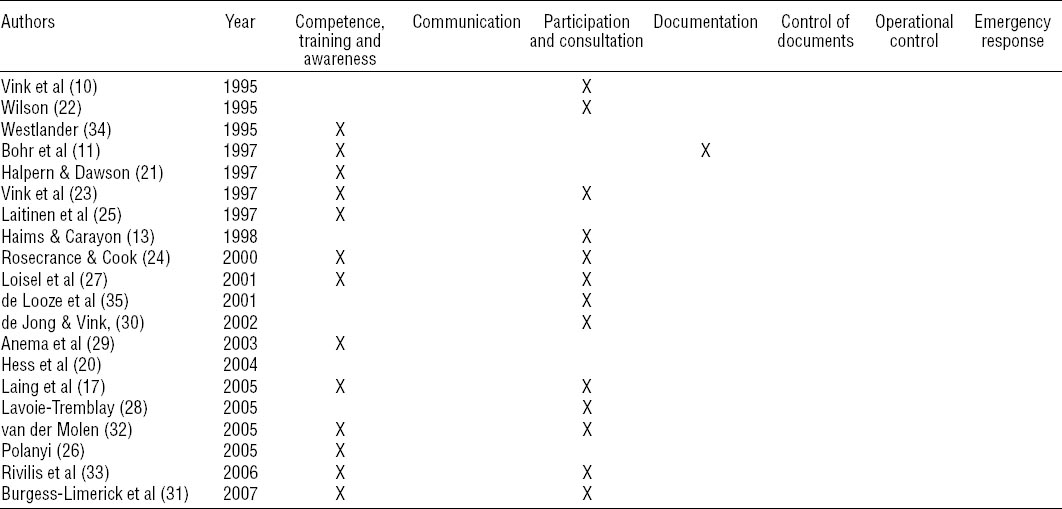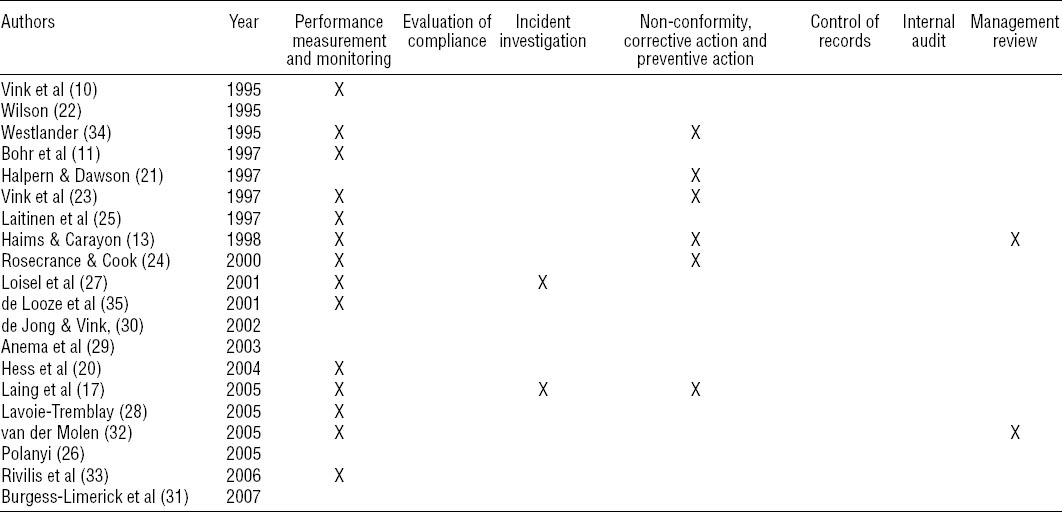Employers have a duty to anticipate, assess, and control a wide range of hazards in order to protect the health and safety of their workers. Many organizations have a business framework that they use to structure their prevention activities. If formalized, it could be considered an occupational health and safety management system (OHSMS). Musculoskeletal disorders (MSD) are a major cause of pain, disability, and costs to workers, employers, and society. It might be expected that MSD prevention activities would draw on methods and approaches like the OHSMS. A forthcoming scoping review (Yazdani et al. Prevention of musculoskeletal disorders within management systems: A scoping review of practices, approaches, and techniques. Submitted to J Appl Ergonomics), however, found there was little information on how MSD prevention activities might be implemented within an OHSMS. Instead, MSD prevention was often described in terms of implementing a stand-alone ergonomics program, often a participatory ergonomics (PE) program. We wondered what challenges and barriers might exist when integrating MSD prevention into an OHSMS.
There is evidence of the effectiveness of both approaches. Robson and colleagues (1) conducted a systematic review of the effectiveness of mandatory and voluntary OHSMS interventions. They found that OHSMS interventions, in general, were effective in managing health and safety related issues. With respect to the effectiveness of PE programs, the systematic review of Rivilis and colleagues (2) concluded there was partial-to-moderate evidence that PE interventions have a positive impact on musculoskeletal symptoms, reducing injuries and workers’ compensation claims, and a reduction in lost days from work or sickness absence.
As part of a larger project on MSD prevention within management systems, we (Yazdani et al. Prevention of musculoskeletal disorders within management systems: A scoping review of practices, approaches, and techniques. Submitted to J Appl Ergonomics) found little information on how MSD prevention might fit into an OHSMS. Given this absence of information, the goal of this paper is to assess the compatibility of elements described in well-cited PE program literature – representing common practice in PE – with the requirements of an OHSMS. Specifically, this paper addresses the question: What are the similarities and differences between an OHSMS framework and PE?
Occupational health and safety management system
An OHSMS is a formalized framework for organizations to manage the health and safety of workers (3). A variety of OHSMS frameworks and guidelines have been developed [eg, the Occupational Health and Safety Assessment Series (OHSAS 18001) (4), British Standard (BS) 8800 (5), and International Labor Organization guidelines (6)]. OHSAS 18001 was developed in response to demands from organizations to assess their management systems against a recognizable OHSMS standard (4). Some countries, like Canada, have developed management system standards for occupational health and safety (OHS) that closely parallel the frameworks described above (8). In Europe, the “OSH Framework Directive” (7) was developed to introduce measures to encourage improvements in the safety and health of workers at work. The Directive contains basic obligations for employers and workers to ensure the health and safety of workers. The directive includes general principles of prevention such as evaluating risks, adapting the work to the individual, adapting to technical progress, developing a coherent overall prevention policy, and prioritizing collective protective measures (7). This framework has been implemented in some European countries such as Sweden.
The main characteristics of proactive OHS management systems that distinguish them from traditional OHS programs are their ability to be integrated into an organization’s other systems, such as quality management, and the incorporation continuous improvement elements (1). Such management systems are generally based on the Plan-Do-Check-Act model (9) of continuous improvement.
Participatory ergonomics
PE is an approach frequently advocated for MSD prevention and has been described simply as “practical ergonomics” or a way to improve problem solving. A myriad of PE approaches have been reported in the literature under multiple taxonomies (10–18). The term “ergonomics program” or “participative ergonomics program” is often used synonymously with MSD prevention. Unless we are quoting from papers, we will use the specific term, MSD prevention. We note however that participation in ergonomics activities has been reported as an approach in the design process and health and safety activities, as well as in prevention in general. This paper is restricted to health and safety activities only.
Methods
In order to assess the compatability of PE programs with OHSMS, it is necessary to describe each approach explicitly. For this purpose, we selected OHSAS 18001 (4) as it represents an internationally recognized, well-practiced approach to the management of health and safety in organizations.
Explicit definition of PE programs
We are not aware of a universally accepted definition of PE. Programs or processes are frequently described whereby cross-functional teams, with representation from stakeholders (eg, workers, management, and engineers) are recruited, trained in ergonomics, perform observations and analyses, and then suggest solutions. However, details and components differ considerably in the literature. Rather than selecting just one of the many definitions, we chose to develop a composite definition based upon the most frequently cited PE papers in the literature. We looked into publications included in van Eerd et al’s recent systematic review which sought literature that addressed context, barriers, and facilitators to the implementation of PE interventions in the workplace (19). They systematically searched multiple electronic databases including MEDLINE, EMBASE, CINHAL, Business Source Premier, Risk Abstracts, CCINFOWeb, Ergonomics Abstracts Online, Scopus, ProQuest Digital Dissertations, Foreign Doctoral Dissertation, Index to Theses (Great Britain and Ireland), IDEAS and Canadian Institute for Scientific Information catalogue, Conference Papers Index, ISI Proceedings, PapersFirst, and ProceedingsFirst. They also searched relevant conference proceedings and reference lists. The authors included PE approaches that had attempted to improve workers’ health by changing work processes, work tools and equipment, and/or work and workplace organizations. Fifty-two documents (33 peer reviewed and 19 gray literature) met their review criteria (19). The authors used a large number of search terms in four broad areas including participation, ergonomics, intervention, and health outcome. The full list of search terms is available in Van Eerd et al (19). The selected papers were from multiple jurisdictions, but mainly Europe, Canada and the US.
We then used the Web of Science citation report tool to determine the total number of citations and average citations per year of each paper. This was performed in August 2012 and updated in October 2013. Papers with ≥10 citations since publication and an average citation rate of ≥1 citations per year were designated as “wellcited” and used as the basis for an inclusive definition of PE.
Framework for comparing OHSMS and PE
For OHSAS 18001 (4), a verbatim description of each element of an OHSMS was created from the document for short clauses. For longer clauses, the main ideas were summarized. These elements provided the headings by which the PE papers were analyzed. Two researchers read each well-cited paper on PE that met our inclusion criteria. Any text in each paper that was related to the elements of OHSAS 18001 was transcribed verbatim into an Excel spreadsheet. We used a content analysis approach to analyze the data extracted from the PE articles. Themes within each element were identified and papers contributing to that theme were noted. Topics related to the establishment and management of PE programs that did not fit into the OHSAS 18001 elements were also noted.
Results
Of the 52 articles reviewed by Van Eerd et al (19), 20 articles met the criteria for selection as a well-cited article (table 1). A total of 21 elements were identified within OHSAS 18001 (table 2). The results are presented according to these OHSMS elements.
Table 1
The total citations and average citations per year for the selected participatory ergonomics papers a.
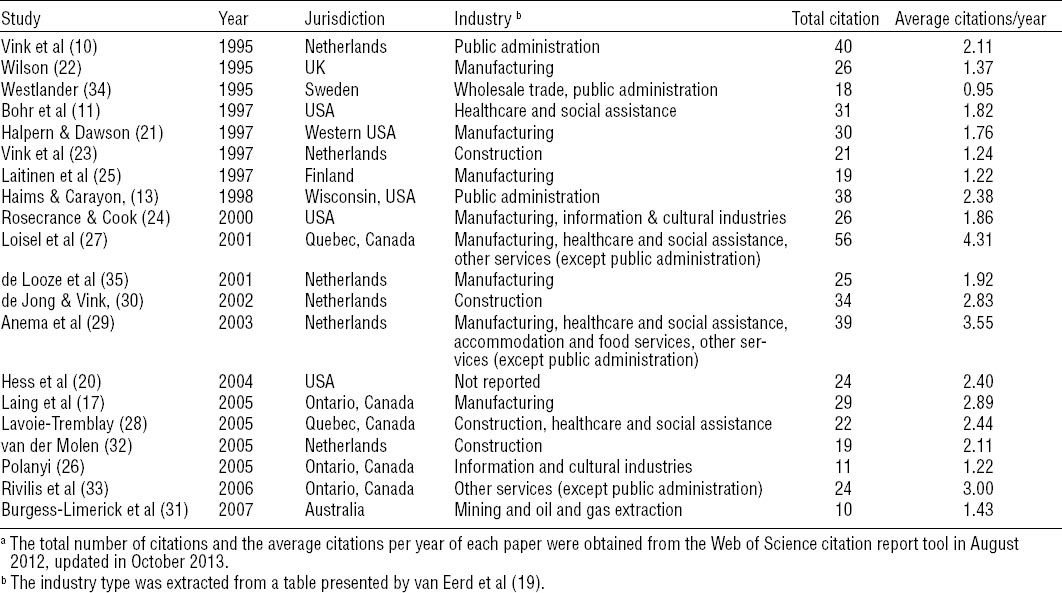
Table 2
Descriptions of elements of occupational health and safety management system based on the Occupational Health and Safety Assessment Series (OHSAS 18001). [OHS=occupational health & safety; OHSMS=occupational health and safety management system.]
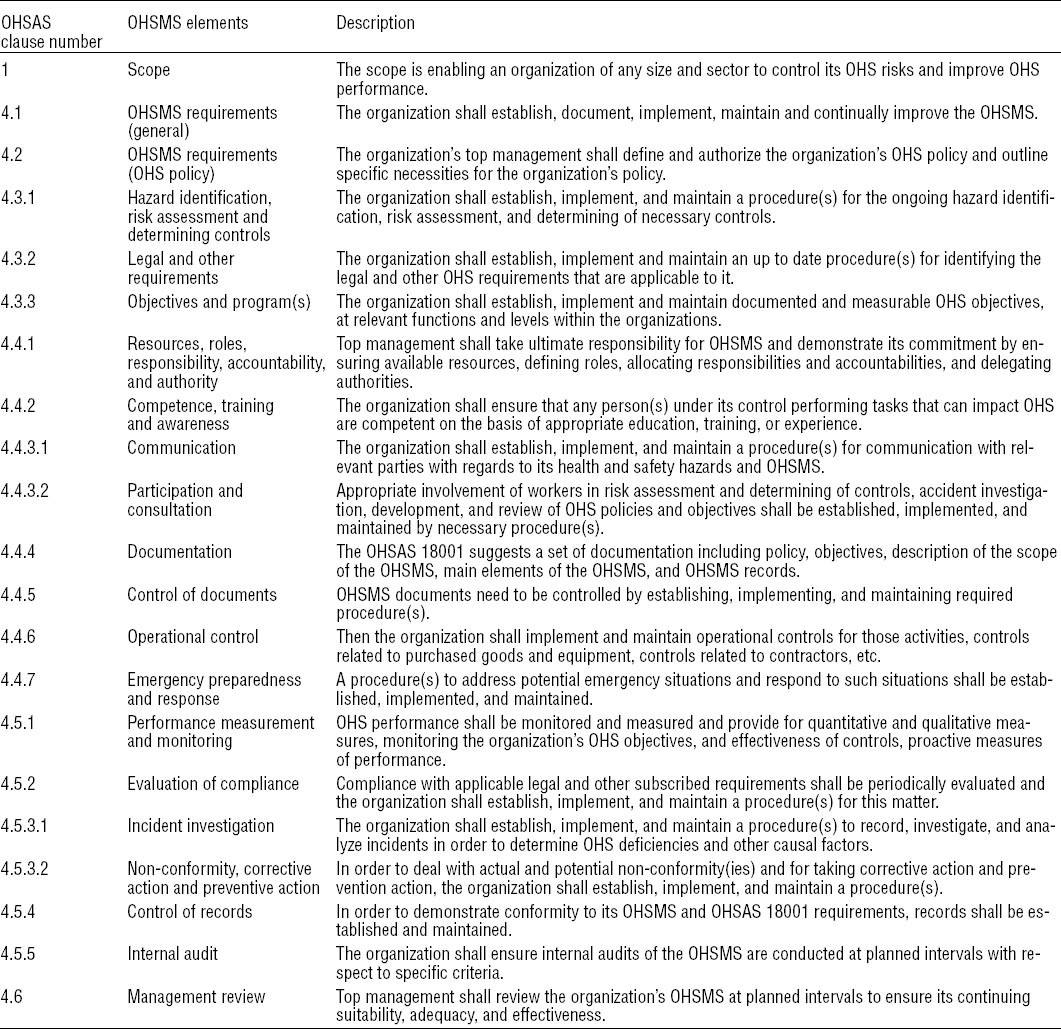
Scope
This element describes the scope of the OHSMS: enabling an organization to control its OHS risks and improve OHS performance. An OHSMS is intended to be applicable to any organization and address OHS issues. The PE programs described in well-cited articles were generally implemented at a department level within workplaces, but there was no information about the possibility of implementing a PE program within the entire workplace.
One article suggested that the scope of the “project” was identified after discussion of a number of trades and job tasks on the construction site (20). The purpose described was to address a specific issue, within a specific workstation or department by a group of researchers, and with the participation of different stakeholders within organizations. There are other examples of this type of strategy in the literature (10, 17, 21–25). Interestingly, only one paper implemented an “in-house continuous improvement” PE program in a public service agency (13). This could be considered as the sole attempt to enable an organization to control MSD risk factors within a continuous improvement framework.
OHSMS requirements (general)
None of the papers addressed this element. There were no recommendations regarding how organizations could maintain, and, more importantly, continuously improve their MSD prevention activities. There was no indication of requirements to be followed and the only indication of continuous improvement, as one of the main requirements of OHSMS, was seen in the article noted in the previous section (13).
OHSMS requirements (OHS policy)
With respect to policy, only one paper reported that the the company’s health, safety and environment manager drafted the “Ergonomic Policy”, which was then revised by the joint labor-management committee (26).
Hazard identification, risk assessment, and determining controls
This element was extensively described in most of the PE papers. Authors used one, or a combination of techniques. Table 3 summarizes the techniques and approaches reported in the well-cited papers to identify and control MSD risk factors.
Objectives and program(s)
Few of the papers partially addressed objectives, while apparently, in most of the PE papers, researchers determined the objective before the start of the project (11). The objectives could be determined by having a group of stakeholders from different departments identify areas that require ergonomic improvement (17, 27), define a mission statement (17), followed by setting a timetable and appointing a person to oversee the follow-up. As reported in well-cited PE papers, proposed solutions should then be presented to the employer for final review and acceptance (27). In one paper, a “commitment contract” was used to indicate the objectives and time frame of the action plans (28). Similarly, another paper indicated that stakeholders should come to agreement on details about responsibilities and timelines, and then an ergonomist should contact the employer to arrange the implementation (29). One paper used a “product sheet” and an “ideas’ book”, followed by a meeting with management and health and safety specialists to determine the objectives (30). Another paper suggested the company’s health, safety and environment manager draft the objectives which the joint labor-management committee would then revise (26). The reviewed articles implied that PE is a project- or intervention-based, relatively short-term process, and may not include continuous improvement.
Resources, roles, responsibility, accountability, authority
This element of OHSMS was partially addressed in many of the well-cited papers. The most common statement was that management commitment is required for the program to be effective (31). With respect to resources, it was suggested that appropriate and adequate resources should be supplied to implement the PE program (11, 17) and that financial commitment should be sought from the organization’s chairman (32). It was also noted that an initial budget was given by management, followed by additional resources allocated by top management upon reviewing a progress report of improvement plans (21).
It was suggested that the president of the company (30) or a management representative appointed by top management (21) should lead the program or that an ergonomist should seek responsible parties for adjustment in the workplace (29). A commitment contract (28) or agreement (17, 27) was used to determine the roles and responsibilities of different stakeholders in the PE program, and involvement of individuals was voluntary (33). It was reported that working hours and personnel resources were made available after senior management became interested in the project (34). It was also reported that the company’s health, safety and environment manager drafted responsibilities which the joint labor-management committee then revised (26).
Competence, training and awareness
Training was regarded as a key element of PE approaches. One paper stated that training should focus on the development of effective skills for working as a group (11). The duration of training in PE programs varied from a single training session (11, 25) to two sessions (27, 34), from 20 hours of training (24) to a series of training sessions (17, 31, 33). The training was conducted through seminars (21, 25), workshops (31, 34), or during what was termed the “main meeting” (23). The training could then be followed by awareness education for other employees (21). Polanyi et al (26) reported that the comprehensive education and training program was conducted as part of a “Stop Repetitive Strain Injury (RSI)” program and was reviewed on a regular basis.
With respect to training content, authors indicated this included: an overview of ergonomics terminology (11), MSD risk factors and task analysis processes (11, 26, 31), use of techniques and a PE program description (17), physical work demand and remedies to control it (32), the PE process (27, 29) theory and methods (29), mechanism of injury associated with manual tasks (31), technical ergonomics for analysis and design committees (21), the importance of hierarchy of controls and general strategies for eliminating and controlling manual tasks injury risk (11), and information about the PE project to increase awareness thereof (23). However, authors indicated neither how they measured the effectiveness of training provided nor how the training could be sustainable and effective.
Participation and consultation
OHSAS 18001 (4) specifies one of the main elements of an OHSMS is the appropriate involvement of workers in risk assessment and determination of controls, accident investigation, and the development and review of OHS policies and objectives.
With respect to this element, most of the well-cited PE papers discussed their approach of seeking employees’ involvement and participation in the ergonomics improvement activities with respect to MSD prevention. Laing et al (17) suggested that the involvement of employees is greatly helped by their participation in “ergonomic change teams”. Lavoie-Tremblay et al (28) suggested that a work team (consisting of different stakeholders) should be set to ensure commitment within the department and the institution. Loisel et al (27) indicated that in their approach, the injured worker, employer and union representative were deeply involved in the redesign process. They noted that being injured should not prevent workers from participating in the work groups (27). Van der Molen (32) reported that different stakeholders from within an organization and an ergonomics consultant participated in their PE project.
As suggested by some authors, workers could select improvements if they received appropriate training and instruction (10) and the participation of trained workers could be achieved by contacting them (13). Different stakeholders within an organization could be actively involved in the PE program and have different roles in working groups such as management, worker, health and safety executive, and member of the steering or ad hoc groups that could be involved at different stages of the program (13, 22). As described by one of the papers, a group evaluated the improvement ideas suggested by employees and then positively evaluated ideas were added to an “idea’s book” (30).
Involvement of employees in one study was facilitated by providing information about the project, the outcomes and their likely effects, and then they were asked if they agreed with the changes (35). In another approach it was reported that all employees were involved by completing checklists, developing suggestions for implementation, testing improvements, and giving their preference (23). However, the authors suggested that the steering committee should decide on the feasibility of proposed improvements, by considering costs and benefits before asking employees for their preference (23). In another study, ergonomic meetings were suggested where employees could participate in the PE process (24). A further study involved employees by having them to complete questionnaires and then seeking their involvement in interventions (33). It was also noted that one organization encouraged employees’ participation by paying overtime for those attending meetings (31).
Documentation
The OHSAS 18001 framework provides a list of documentation including policy, objectives, and a description of the scope, main elements, and records that should be available through an OHSMS. Only one paper addressed documentation, where the authors stated that methods of documentation should be provided (11).
Performance measurement and monitoring
Most of the papers addressed this element. Authors used a variety of techniques to measure the effectiveness of changes (table 4).
Incident investigation
The OHSAS 18001 (4) framework requires that the organization shall establish, implement and maintain a procedure(s) to record, investigate, and analyze incidents in order to determine OHS deficiencies and other causal factors. Only two authors mentioned a mechanism for incident investigation. One reported that methods for calculating job and department level injury incidence and severity rates were introduced (17). In addition, a pain/symptom survey was introduced. The other collected occupational histories and past histories of MSD of injured workers, descriptions of job tasks, workers’ workplace medical files, and description of any past work accidents (27).
Non-conformity, corrective action, and preventive action
According to OHSAS 18001 (4), in order to deal with actual and potential non-conformity(ies) and to take corrective action and prevention action, the organization shall establish, implement, and maintain a procedure(s).
Haims and Carayon (13) stated that in order to educate workers on solution implementation, the ergonomist should provide information and instruction to workers about the new approach. The supervisors were also informed of the ways that they could encourage and guide the worker in new work situations. Using a similar approach, Vink et al (23) reported that instructional videos were developed, including working methods with reduced physical workload, and employees were informed about new situations. Halpern and Dawson (21) describe a coordinated effort to translate the intervention and abatement strategies into production design changes: while the maintenance department was implementing changes, the engineering department was incorporating them into its new products and new manufacturing sites (21). Both Laing et al (17) and Rosecrance and Cook (24) had the ergonomic committee test the solutions prior to full-scale implementation. Westlander et al (34) stated that the intervention had been scheduled after pre-intervention analysis. The short-term intervention was implemented for current problems, followed by long-term intervention for future problems.
Management review
According to OHSAS 18001 (4), an organization’s top management shall review the OHSMS at planned intervals to ensure its continuing suitability, adequacy, and effectiveness.
Only two of the papers mentioned a mechanism for management review. One noted that information directed to middle management and feedback about using ergonomic measures directed towards employees could strengthen the commitment, communication, and support for incorporating the new policy to use ergonomic measures within the company (32). Another reported that “Breakthrough Thinking” methodology was used to establish purpose, goals, program structure, and plans for the future, one year after the initiation of an Ergonomic Coordinator program (13).
Elements not reported
Eight elements of OHSMS based on the OHSAS 18001 framework (4) went unmentioned in the well-cited PE papers: (i) legal and other requirements; (ii) communication; (iii) control of documents; (iv) operational control; (v) emergency preparedness and response; (vi) evaluation of compliance; (vii) control of records; and (vii) internal audit.
A summary of the presence of elements of OHSAS 18001 (4) in the PE articles is shown in table 5. We did not find concepts within the PE papers that were not addressed in OHSAS 18001’s elements (4).
Table 5a
Presence of Occupational Health and Safety Assessment Series (OHSAS 18001) elements in participatory ergonomics articles. [OHS=Occupational health & safety; OHSMS=occupational health & safety management system.]
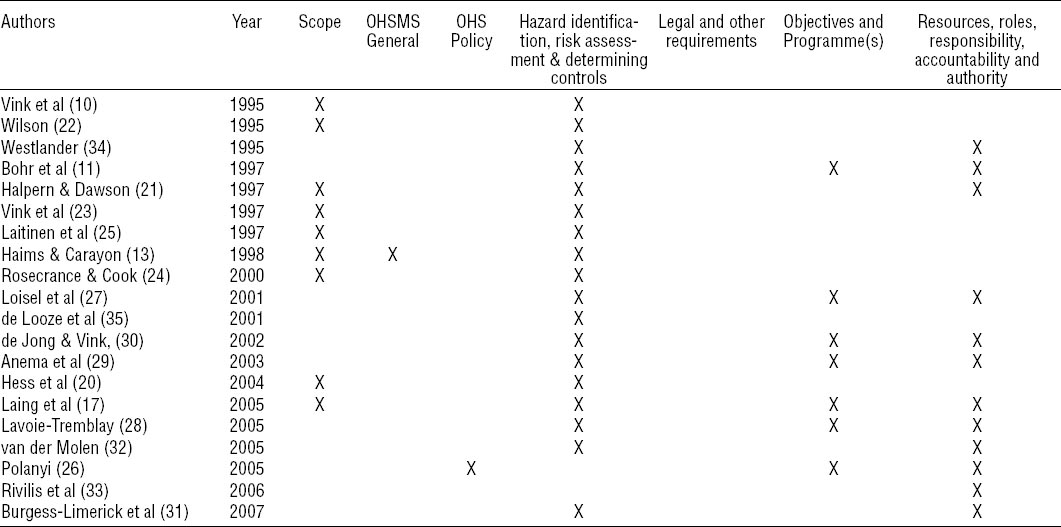
Discussion
The PE papers described approaches for improving workplace ergonomics, but they were actually aimed at preventing MSD, except for Laitinen et al (25), which was an ergonomic development program that was implemented in conjunction with a housekeeping program. In addition, as Loisel et al (27) described in their study, the PE program was implemented in a rehabilitation rather than prevention context. However, the authors argued that the implementation of PE resulted in increasing the awareness of back-pain risk factors in the workplace, which can potentially impact primary prevention. The PE program was implemented at organizational level, involving multiple stakeholders within an organization, to modify the work demands and improve work tasks of workers with back injuries, and hence is worthy of inclusion in this analysis. In their study, before subject recruitment, employer and union representatives of several workplaces received PE training and then workers with back pain were recruited and an ergonomist met them first at the clinic. These are examples of the diverse use of the PE approach.
Of the 21 elements of the OHSAS 18001 framework, although silent on eight, the PE literature did however provide a substantial amount of detail on five of the elements: (i) hazard identification, risk assessment and determining controls; (ii) resources, roles, responsibility, accountability, and authority; (iii) competence, training and awareness; (iv) participation and consultation; and (v) performance measurement and monitoring. However, the authors used many different approaches to address these elements. The findings of this study suggest that, irrespective of the strength of PE, it does not match business processes and practices. Analysis of the content of well-cited PE articles suggests that the implementation of PE programs has not been reported or written about in a fashion that facilitates easy integration into an organization’s management system because of the structure and language differences. PE appears to be regarded as a stand-alone program to solve a specific problem or sets of problems.
It is worth noting that even when the PE literature addressed the management system elements, the vocabulary that was employed in the PE literature often differed from that used in a management system framework. For instance, one of the main elements of OHSAS 18001 describes how organizations should determine measurable objectives and targets (4). Also, the input and output requirements and data should be outlined precisely. However, few of the authors mention this element and the description was limited to using terms such as “commitment contract” (28) or “stakeholder agreement” on an existing problem (29). The process and language introduced in OHSAS 18001 suggests a more systematic approach that enables continuous improvement. In addition, OHSMS elements can be easily integrated into other management system practices and approaches, such as environment or quality. PE approaches described appear to lack these capabilities, or it could be said that the authors did not describe how prevention activities using PE methodology could be integrated into an organization’s broader management system.
The approaches used by Laing et al (17), which were based upon the Participatory Ergonomics Implementation Blueprint developed by Wells et al (36), and the program reported by Loisel et al (27), were examples of approaches that were most similar to the OHSAS 18001 framework (4). Haims and Carayon (13) were the only authors to describe a continuous improvement approach (for the PE process), which is one of the main features of any management system. Zink (37) made a distinction between “selective” and “continuous improvement” participation: using participatory practices for specific organizational projects, such as implementing new technology, refers to selective participation. For continuous improvement, the authors suggested the use of participatory practices in an attempt to achieve continuous improvement within an organization (13, 37). It is worth noting that Kaizen and Six-sigma also encourage a participatory approach and are well-practiced and popular approaches used by organizations across different sectors to solve specific problems.
With respect to sustainability, it was reported that the research team provided expertise, time, and effort as resources to the project, and they created “an ergonomics library” (13). It was suggested that outside experts should leave the organization with an internal program in place that would be capable of addressing future problems (13). Haims and Carayon (13) stated that in order to ensure suitability, the Ergonomic Coordinator program be evaluated and continuous improvement was planned in their PE program. In addition, Liang et al (17) reported that following the withdrawal of the research team, a plantor union-based ergonomics champion might enhance Ergonomic Change Teams sustainability. However, Bohr et al (11) and Burgess-Limerick et al (31) reported some signs of sustainability in their implanted PE program. As the PE literature seems to have been written by researchers for researchers, there was only a moderate amount of detail about how to implement and structure a PE program within a target organization.
It could be argued that research publication did not allow detail of implementation as needed by practitioners. This could potentially make PE difficult to implement successfully by practitioners and organizations.
The literature showed that the scope of the PE programs described was usually limited to a departmental or similar level. As such, PE could be considered similar to other improvement processes such as Six-Sigma. The Six-Sigma approach, though, emphasizes “measurement” whereas in the PE literature, a qualitative approach is frequently employed. In addition, Six-Sigma can be used widely within an organization to address multiple issues, in contrast to PE, which has a much narrower application, often only for MSD prevention. More generally, the PE literature seldom referred to methods or systems used in other areas of a company (eg, quality), organizational change, process improvement (eg, Six-Sigma or Kaizen) or other engineering approaches. Introducing ideas from related well-regarded business and engineering processes has the potential to strengthen MSD prevention. Similarly, introducing MSD prevention into business and engineering processes and methodologies also has the potential to improve MSD prevention, especially hazard identification and control. For example, it has been shown that it is feasible to integrate PE approaches into by Kaizen events as conducted in the lean manufacturing tradition (38).
PE articles did not typically comment on the sustainability of their approach and its continuous improvement capability. As might be expected, researchers or an outside party conducted the majority of studies found in the well-cited PE literature, and these were usually of short-to-moderate duration. It could be speculated that making future improvements would require the return of the researchers to the organization. Consequently, the sustainability of these programs is usually unknown. Management system frameworks, such as OHSAS 18001 by virtue of its continuous improvement nature and compatibility with business processes, tend to lead to sustainable prevention activities (39). Therefore, in order to achieve a sustainable and effective approach to prevention of MSD using a PE approach, more integration into management system frameworks using a continuous improvement method may be useful. PE can be used in a process-oriented organization but its integration into other processes within an organization has not been reported, and it therefore seems unlikely to achieve sustainable prevention. Hence, it may remain a parallel process that will require resources to keep it alive on an ongoing basis. This may make PE too costly for an organization that is trying to streamline its processes, which may mean that PE is seen as an outlier that could be eliminated.
Burgess-Limerick et al (31) noted that the greatest progress towards becoming self-sufficient was seen in a company where the PE program was adopted within the company’s “site standard”, and program sustainability was therefore less likely to be affected by personnel changes. The natural fit of OHSMS with the normal way of doing business makes this an excellent opportunity to bring health and safety and MSD prevention to the table. This could occur by harmonizing concepts and terminologies for MSD hazard assessment with those commonly used in OHSMS or similar management system approaches.
Recently, there have been a few attempts by researchers to develop new PE frameworks such as development of Stay@Work by Driessen et al (40). The authors suggested that despite the positive feedback about the PE program and training using their framework, the implementation of the prioritized ergonomics changes (measures) was lower than expected.
The findings of this study are restricted by relying only on the peer-reviewed and grey literature identified by Van Eerd et al (19). PE approaches developed by individual companies and consultancies may have different characteristics. However, we chose to use 20 papers from multiple countries that were well-cited (table 1). The study sought only English language papers but the selected papers represent many different countries including the USA, Canada, Australia, and multiple European countries. Our definition of OHSMS was based on a single framework, OHSAS 18001 (4); nevertheless, other frameworks such as BS 8800 (5), International Labour Organization guidelines (6) or CSA-Z1000 are very similar (6–8).
A number of the PE programs have been implemented within research studies. Constraints that might have been introduced by this method include shortened timelines for obtaining pre-post measures, a lack of consideration of the sustainability beyond the study duration or the provision of substantial outside consulting, and facilitation resources by the research team. This may have affected the form of PE program from that which might be seen in organizations outside of a research study.
Concluding remarks
Both PE and OHSMS frameworks have evidence of success in addressing workplace hazards. Importantly, we did not find any conflict between these approaches. This suggests that MSD prevention activities and approaches such as PE could be beneficially integrated into existing management structures. This approach would supply PE’s absent elements. We therefore believe that paying attention to and adopting management approaches as well as the language used in management system frameworks could make MSD prevention activities using PE more effective and sustainable.


